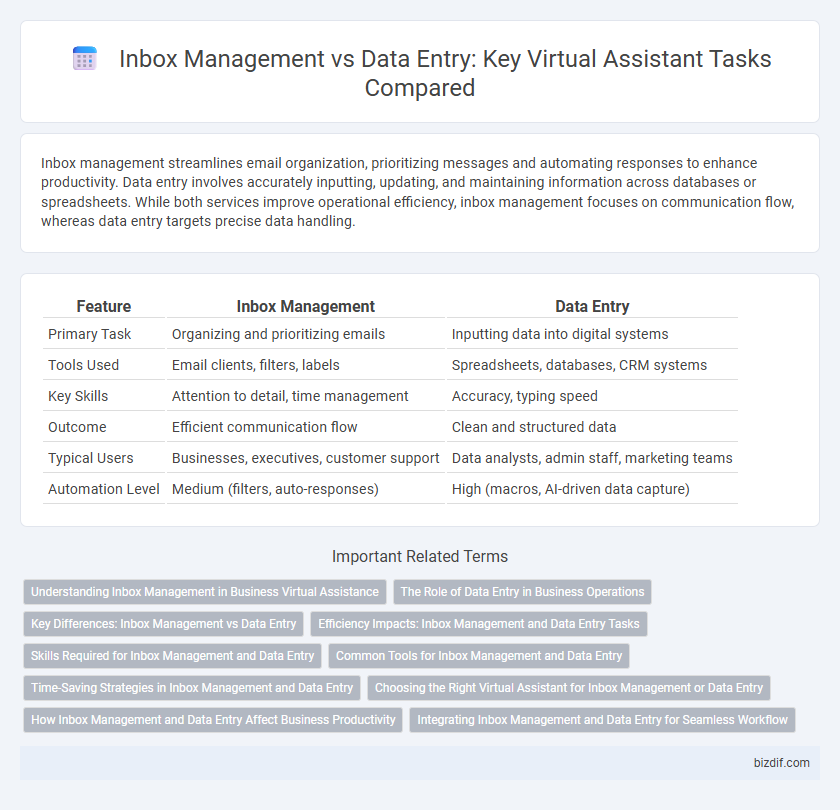Inbox management streamlines email organization, prioritizing messages and automating responses to enhance productivity. Data entry involves accurately inputting, updating, and maintaining information across databases or spreadsheets. While both services improve operational efficiency, inbox management focuses on communication flow, whereas data entry targets precise data handling.
Table of Comparison
| Feature | Inbox Management | Data Entry |
|---|---|---|
| Primary Task | Organizing and prioritizing emails | Inputting data into digital systems |
| Tools Used | Email clients, filters, labels | Spreadsheets, databases, CRM systems |
| Key Skills | Attention to detail, time management | Accuracy, typing speed |
| Outcome | Efficient communication flow | Clean and structured data |
| Typical Users | Businesses, executives, customer support | Data analysts, admin staff, marketing teams |
| Automation Level | Medium (filters, auto-responses) | High (macros, AI-driven data capture) |
Understanding Inbox Management in Business Virtual Assistance
Inbox management in business virtual assistance involves organizing, prioritizing, and responding to emails and messages efficiently to enhance productivity and communication flow. Unlike routine data entry, inbox management requires critical thinking to categorize urgent tasks, filter spam, and schedule follow-ups that align with business priorities. Effective inbox management minimizes missed opportunities and ensures timely decision-making, making it a crucial service for growing companies.
The Role of Data Entry in Business Operations
Data entry plays a critical role in business operations by ensuring accurate organization and recording of information, which supports effective decision-making and workflow efficiency. Unlike inbox management, which focuses on sorting and prioritizing emails, data entry involves systematically inputting, updating, and maintaining data in digital systems to drive operational processes. High-quality data entry enhances customer relationship management, inventory tracking, and financial reporting, making it essential for seamless business functionality.
Key Differences: Inbox Management vs Data Entry
Inbox management involves organizing, prioritizing, and responding to emails to ensure efficient communication flow, while data entry focuses on accurately inputting and updating information into databases or systems. Effective inbox management enhances time-sensitive decision-making, whereas data entry prioritizes accuracy and consistency of data for reporting and analysis. Both tasks require attention to detail, but inbox management demands strong organizational and communication skills, contrasting with the repetitive and detail-oriented nature of data entry.
Efficiency Impacts: Inbox Management and Data Entry Tasks
Inbox management streamlines communication flow by prioritizing emails and ensuring timely responses, significantly reducing response times and increasing overall productivity. Data entry tasks, while essential for accurate record-keeping, often consume substantial time and can introduce errors if not managed effectively through automation tools. Efficient handling of inbox management combined with optimized data entry workflows enhances operational efficiency, minimizes bottlenecks, and supports better decision-making.
Skills Required for Inbox Management and Data Entry
Inbox management demands strong organizational skills, proficiency in email platforms, and effective prioritization to handle large volumes of correspondence efficiently. Data entry requires high typing speed, accuracy, and familiarity with data management software to ensure error-free input and database maintenance. Both roles benefit from attention to detail, time management, and basic computer literacy skills.
Common Tools for Inbox Management and Data Entry
Common tools for inbox management include Microsoft Outlook, Gmail, and Slack, which streamline email sorting, prioritization, and task assignments. Data entry tools such as Microsoft Excel, Google Sheets, and specialized software like Airtable enhance accuracy and efficiency by automating data input and organization. Integrating these tools with platforms like Zapier or Microsoft Power Automate optimizes workflows between inbox management and data entry tasks.
Time-Saving Strategies in Inbox Management and Data Entry
Effective inbox management utilizes automated sorting, prioritization, and filtering tools that reduce email overload and response time, allowing virtual assistants to handle communications swiftly. Data entry efficiency improves through the use of template-based inputs and bulk processing software, minimizing manual errors and accelerating task completion. Combining these time-saving strategies enhances overall productivity by streamlining repetitive workflows and freeing up valuable hours for higher-value responsibilities.
Choosing the Right Virtual Assistant for Inbox Management or Data Entry
Selecting the right virtual assistant depends on specific task requirements: inbox management demands skills in email filtering, scheduling, and prioritization, while data entry requires accuracy, speed, and attention to detail. Platforms like Upwork and Fiverr offer specialized virtual assistants with verified expertise tailored to these distinct tasks. Evaluating experience with tools like Microsoft Outlook for inbox management or Excel for data entry ensures optimal performance and efficiency.
How Inbox Management and Data Entry Affect Business Productivity
Efficient inbox management streamlines communication flow, enabling faster response times and reducing missed opportunities, which directly boosts business productivity. Accurate data entry ensures reliable information is available for decision-making, minimizing errors and saving time spent on corrections. Both processes complement each other by enhancing operational efficiency and fostering a more organized business environment.
Integrating Inbox Management and Data Entry for Seamless Workflow
Integrating inbox management and data entry streamlines workflows by automating the capture and organization of incoming information, reducing manual errors and saving valuable time. Virtual assistants equipped with AI can filter, categorize, and input data directly into relevant systems, ensuring real-time updates and accuracy. This seamless integration enhances productivity and allows businesses to focus on strategic tasks rather than repetitive administrative duties.
Inbox management vs Data entry Infographic

 bizdif.com
bizdif.com